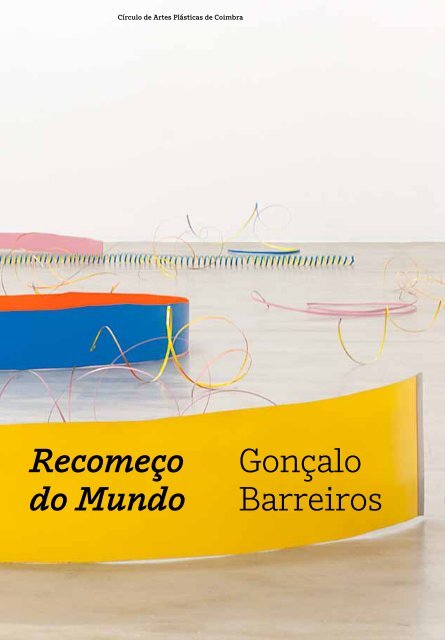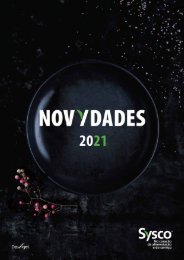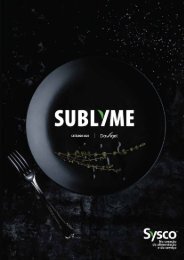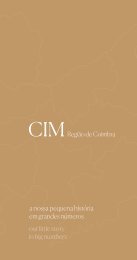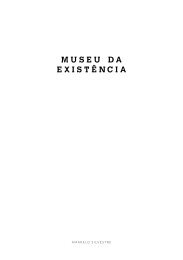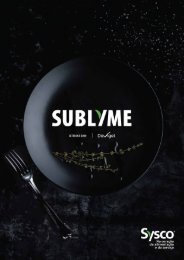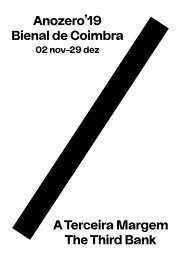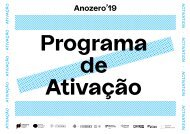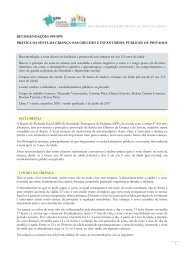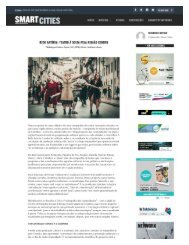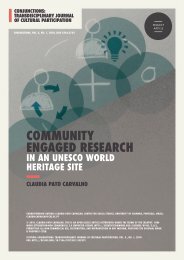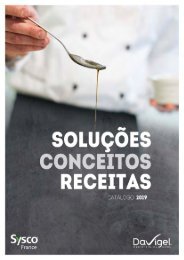Recomeço do Mundo
Catálogo da exposição de Gonçalo Barreiros no Círculo de Artes Plásticas de Coimbra, de 2 de junho a 14 de julho de 2018
Catálogo da exposição de Gonçalo Barreiros no Círculo de Artes Plásticas de Coimbra, de 2 de junho a 14 de julho de 2018
You also want an ePaper? Increase the reach of your titles
YUMPU automatically turns print PDFs into web optimized ePapers that Google loves.
Círculo de Artes Plásticas de Coimbra<br />
<strong>Recomeço</strong><br />
<strong>do</strong> Mun<strong>do</strong><br />
Gonçalo<br />
Barreiros
Círculo de Artes Plásticas de Coimbra<br />
<strong>Recomeço</strong> <strong>do</strong> Mun<strong>do</strong><br />
—<br />
Gonçalo Barreiros<br />
—<br />
Círculo Sereia<br />
2 jun – 14 jul<br />
2 Jun – 14 Jul<br />
2018<br />
3
Círculo de Artes Plásticas de Coimbra<br />
Biografia<br />
Gonçalo Barreiros<br />
Gonçalo Barreiros vive e trabalha em Lisboa. É forma<strong>do</strong> em Escultura<br />
pela escola Ar.Co e mestre em Belas Artes, pela Slade School of Fine<br />
Arts de Londres, com a bolsa da Fundação Calouste Gulbenkian.<br />
Em 2004, fez a residência artística atribuída pela CML em Budapeste.<br />
Das suas exposições individuais, destacam-se: Vraum, Chia<strong>do</strong> 8<br />
(Lisboa, 2013); n.º 17, Empty Cube, no CAPC – Círculo de Artes Plásticas<br />
de Coimbra (2013), e Woodpecker, na Ermida de Bélem (Lisboa, 2012).<br />
O seu trabalho integra várias exposições coletivas — nomeadamente<br />
Involuntary Memory, Luís Adelanta<strong>do</strong> (Valência, 2017); Sala <strong>do</strong>s Gessos,<br />
Museu da Eletricidade (Lisboa, 2016); Sem título é um bom título, Ar<br />
Sóli<strong>do</strong> (Lisboa, 2016); Materiais Transitórios, Sociedade Nacional de<br />
Belas Artes (Lisboa, 2016); Canal Caveira, Cor<strong>do</strong>aria Nacional (Lisboa,<br />
2015); O Riso, Museu da Eletricidade (Lisboa, 2012); Plus 1, Perry<br />
Rubenstein Gallery (Nova Iorque, 2010); Triangle Room (Programa<br />
Curatorial <strong>do</strong> Chelsea College of Art and Design, 2008) — e o Prémio<br />
EDP – Novos Artistas, Museu de Serralves (Porto, 2003).<br />
Nos últimos anos, tem apresenta<strong>do</strong> regularmente o seu trabalho<br />
na Galeria Vera Cortês, destacan<strong>do</strong>-se as suas exposições individuais<br />
3/4 (2006), quero eu fazer as coisas… (2008), Nosey Parker e, mais<br />
recentemente, Declaração Amigável (2017).<br />
5
Círculo de Artes Plásticas de Coimbra<br />
O que resta é um para<strong>do</strong>xo<br />
Referi uma vez o artista Bruce Nauman, a propósito <strong>do</strong> trabalho de<br />
Gonçalo Barreiros, num livro trabalha<strong>do</strong> a quatro mãos, entre mim e<br />
o artista, 1 no que respeita ao contexto da sua utilização da palavra nas<br />
obras e nos títulos destas. A questão que me levou a apontar o fonema,<br />
a palavra escrita, a sua locução, ou a inscrição resgatada a um objecto<br />
apropria<strong>do</strong> e, posteriormente, recontextualiza<strong>do</strong> — como, por exemplo,<br />
Sem título, Tampa de esgoto, de 2008 — mantém-se presente e é<br />
absolutamente indissociável da poética e <strong>do</strong> carácter disruptivo <strong>do</strong> seu<br />
trabalho, mas também da sua ressonância com a manualidade <strong>do</strong> trabalho<br />
de escultor e a sua dimensão conceptual.<br />
<strong>Recomeço</strong> <strong>do</strong> Mun<strong>do</strong> é o título de uma instalação de grandes, e variáveis,<br />
dimensões que ocupa as três salas da arquitectura equilibrada e<br />
funcional que caracteriza o espaço <strong>do</strong> CAPC, o Círculo de Artes Plásticas<br />
de Coimbra. Esta obra é trabalhada a partir de restos, desperdícios<br />
de outras obras, sen<strong>do</strong> aqui conveniente recordar a exposição realizada<br />
na Galeria Vera Cortês, sob o título Declaração Amigável 2 , também<br />
com uma única obra no espaço da galeria. Nesta obra, datada de 2017,<br />
Gonçalo Barreiros esventrava a galeria, deixan<strong>do</strong> o seu espaço amplo<br />
quase intoca<strong>do</strong>, utilizan<strong>do</strong> apenas uma parede com o senti<strong>do</strong> de concentrar<br />
o corpo <strong>do</strong> especta<strong>do</strong>r em confronto com os círculos informes que<br />
constituem essa escultura, que nos reenvia para modelos de câmaras de<br />
ar de diferentes dimensões pertencentes a velocípedes ou outros veículos<br />
motores. Mas esses objectos encosta<strong>do</strong>s, como se estivessem numa oficina<br />
a aguardar a resolução da hipotética «declaração amigável», remetem<br />
para um para<strong>do</strong>xo relacional entre a possibilidade remota da referência<br />
utilizada e a operatividade <strong>do</strong> objecto artístico enquanto palimpsesto<br />
<strong>do</strong> seu significa<strong>do</strong> material e simultaneamente da sua nomeação, que<br />
se perpetua na reinscrição da palavra na nossa memória.<br />
Nas duas obras que refiro, existem algumas aproximações e outras<br />
tantas contradições. O que as aproxima, além <strong>do</strong> factor humano presente<br />
na manualidade que o trabalho <strong>do</strong> ferro ou <strong>do</strong> aço exige, é o pensamento<br />
sobre o espaço e o seu contexto, patente na forma como são expostas,<br />
ocupan<strong>do</strong> de forma diversa to<strong>do</strong> o espaço, onde a obra e o seu contentor<br />
se fundem como um objecto singular e específico. Concorre para esta<br />
aproximação a disposição <strong>do</strong> título, como já mencionei, e acentuo o<br />
termo «disposição», da<strong>do</strong> que este é de tal forma operativo e desestabiliza<strong>do</strong>r<br />
<strong>do</strong>s vários senti<strong>do</strong>s que as obras vão activan<strong>do</strong>, fazen<strong>do</strong> parte<br />
da composição destas, tal como a pintura que reveste os metais de que<br />
são feitas e que têm uma enorme importância no tempo de observação<br />
e na estranheza a que é sujeito o especta<strong>do</strong>r.<br />
1. Tar<strong>do</strong>z, ed. Vera<br />
Cortês Art Agency,<br />
2014.<br />
2. http://www.<br />
veracortes.com/<br />
exhibitions/<br />
archive/2017<br />
7
<strong>Recomeço</strong> <strong>do</strong> Mun<strong>do</strong> Gonçalo Barreiros<br />
Círculo de Artes Plásticas de Coimbra<br />
Por um la<strong>do</strong>, o <strong>Recomeço</strong> <strong>do</strong> Mun<strong>do</strong> é na sua totalidade uma metáfora<br />
da reinvenção <strong>do</strong> mun<strong>do</strong> enquanto experiência subjectiva da obra que<br />
se mostra na intermitência <strong>do</strong> seu reflexo lumínico e da extensão das<br />
salas <strong>do</strong> CAPC, e que reaparecen<strong>do</strong> desaparece por entre fios de cor,<br />
lâminas polícromas ou corpos helicoidais que aparentemente nos<br />
guiam o olhar. Mas esta não é uma obra para observar num exercício<br />
de aproximação e distanciamento em que se reconhecem as diferenças<br />
de grandeza entre as formas e os micro-acontecimentos que estas<br />
encerram. Aparece-nos como uma paisagem que, ao ser percorrida, nos<br />
faz sentir a inabilidade <strong>do</strong> corpo que a pode ferir, por exemplo, pisan<strong>do</strong>-a,<br />
o que nos coloca perante a contingência <strong>do</strong> espaço frente ao corpo que<br />
já não o reconhece. Por isso, é provável que seja necessário recomeçar<br />
a reaprender a olhar, a reconstituir a nossa corporalidade com uma<br />
capacidade perceptiva que poderíamos identificar como performativa.<br />
Mas a performatividade não é a intenção <strong>do</strong> artista, porque a pulsão<br />
que está na base desta imensidão é apenas uma aritmética simples que<br />
adiciona elementos na sua composição espacial e na dimensão que estes<br />
podem acrescentar a outros. To<strong>do</strong>s provenientes <strong>do</strong> desbaste, da acção<br />
transforma<strong>do</strong>ra que outras obras exigiram e que foi fican<strong>do</strong> como se o<br />
ateliê fosse, no seu limite, excessivo: um imenso repositório de memórias<br />
e de procedimentos. E no final, essas sobras são nada menos <strong>do</strong> que a<br />
matéria iniciática e necessária para repensar uma ideia de espaço sem<br />
perder de vista o local da exposição e as suas condições arquitectónicas.<br />
Mas, por outro la<strong>do</strong>, o trabalho de Gonçalo Barreiros é pauta<strong>do</strong> por<br />
uma disciplina austera que se concentra nas condições e relações que a<br />
sua obra pode criar na exposição enquanto dispositivo perceptivo que<br />
vai accionar to<strong>do</strong>s os senti<strong>do</strong>s humanos. Seja através de um desenho, <strong>do</strong><br />
som, de um ruí<strong>do</strong>, de uma palavra, de um zumbi<strong>do</strong> ou de uma estridência<br />
metálica; mas, também, da instabilidade <strong>do</strong> equilíbrio, da diferença de<br />
escalas e proporções, ou da ausência da cor e, para<strong>do</strong>xalmente, da sua<br />
presença multifilar, entrecortada em planos e linhas dispersos como se<br />
uma anamorfose se apoderasse <strong>do</strong> espaço. Neste caso em concreto, <strong>do</strong>s<br />
três espaços das galerias.<br />
Em <strong>Recomeço</strong> <strong>do</strong> Mun<strong>do</strong>, Gonçalo Barreiros reconfigura uma ideia<br />
que se materializa como um comentário ao caos, não ao caos cósmico,<br />
mas a uma ideia de caducidade das normas e da métrica que a escultura/<br />
instalação indexa a esse esta<strong>do</strong> iniciático que se constrói a partir <strong>do</strong> que<br />
já não é nomeável, já não tem forma que o defina e, por isso mesmo, é<br />
uma matéria em esta<strong>do</strong> puro, pronta a ser trabalhada como se fosse a<br />
primeira vez, embora conten<strong>do</strong> todas as anteriores que ali (re)começam.<br />
Contu<strong>do</strong>, esta exposição, tal como a obra que inicialmente referi, Sem<br />
título, Tampa de esgoto, de 2008, é uma tentativa, e um desafio, que diz<br />
respeito a uma questão importante na história da arte: a especificidade<br />
de uma obra num contexto e num espaço determina<strong>do</strong>, e não qualquer<br />
outro. O que me faz recordar, e retomar, uma citação de Richard Serra<br />
que passo a transcrever: «The specificity of site-oriented works means<br />
that they are conceived for, dependent upon, and inseparable from their<br />
location. Scale, size, and placement of sculptural elements result from an<br />
analysis of the particular environmental components of a given context.<br />
The preliminary analysis of a given site takes into consideration not only<br />
formal but social and political characteristics of the site.» 3<br />
O projecto para as galerias <strong>do</strong> CAPC é uma proposta que encerra em<br />
si mesma a reconstrução desse espaço enquanto lugar de trabalho que<br />
se prolonga sem princípio nem fim que o defina, pois, ao entrarmos nele,<br />
constituímo-nos como uma parte <strong>do</strong> seu movimento perpétuo que só<br />
ali pode ter a sua existência, independentemente <strong>do</strong> devir, mas sem<br />
dúvida como um desenho que introduz um vínculo orgânico no rigor<br />
e na memória da sua arquitectura.<br />
João Silvério*<br />
3. Ver Richard Serra,<br />
«from the Yale<br />
Lecture», in Art in<br />
Theory 1900-2000:<br />
an anthology of<br />
changing ideas -<br />
Malden, Oxford and<br />
Victoria: Blackwell,<br />
2006 (new edition),<br />
p. 1098.<br />
* O autor não segue<br />
o recente Acor<strong>do</strong><br />
Ortográfico.<br />
8 9
<strong>Recomeço</strong> <strong>do</strong> Mun<strong>do</strong> Gonçalo Barreiros<br />
Círculo de Artes Plásticas de Coimbra<br />
Biography<br />
Gonçalo Barreiros<br />
Gonçalo Barreiros lives and works in Lisbon. He studied Sculpture<br />
at the Ar.Co school and has a master’s in Fine Arts from the Slade<br />
School of Fine Arts in Lon<strong>do</strong>n, under a scholarship from the Fundação<br />
Calouste Gulbenkian.<br />
In 2004 he had an artistic residency in Budapest, assigned by the<br />
Lisbon City Council.<br />
Among his individual exhibitions, the following can be highlighted:<br />
Vraum, Chia<strong>do</strong> 8 (Lisbon, 2013); no. 17, Empty Cube, in CAPC – Círculo<br />
de Artes Plásticas de Coimbra (2013), and Woodpecker, in Ermida de<br />
Bélem (Lisbon, 2012).<br />
His work is part of several collective exhibitions – namely Involuntary<br />
Memory, Luís Adelanta<strong>do</strong> (Valencia, 2017); Sala <strong>do</strong>s Gessos, Museu<br />
da Eletricidade (Lisbon, 2016); Sem título é um bom título, Ar Sóli<strong>do</strong><br />
(Lisbon, 2016); Materiais Transitórios, Sociedade Nacional de Belas<br />
Artes (Lisbon, 2016); Canal Caveira, Cor<strong>do</strong>aria Nacional (Lisbon, 2015);<br />
O Riso, Museu da Eletricidade (Lisbon, 2012); Plus 1, Perry Rubenstein<br />
Gallery (New York, 2010); Triangle Room (Chelsea College of Art and<br />
Design Curatorial Programme, 2008) – and the EDP Award for New<br />
Artists, Museu de Serralves (Porto, 2003).<br />
In recent years, he has regularly exhibited his work in Galeria Vera<br />
Cortês, with highlights being his solo exhibitions 3/4 (2006), quero eu<br />
fazer as coisas… (2008), Nosey Parker and more recently, Declaração<br />
Amigável (2017).<br />
What remains is a para<strong>do</strong>x<br />
I once mentioned Bruce Nauman’s work while writing about<br />
the work of Gonçalo Barreiros in a book authored by both of<br />
us. The reference focused on his use of the written word in<br />
his pieces and in their titles. Taken from appropriated and<br />
recontextualized objects, as in Untitled, Manhole Cover (2008),<br />
phonemes, the written word, their utterance or inscription have<br />
a central importance in Barreiro’s disruptive work and poetics,<br />
resonating with the craftsmanship and conceptual facet of the<br />
sculptor’s work.<br />
<strong>Recomeço</strong> <strong>do</strong> Mun<strong>do</strong> [The Renewal of the World] is the title<br />
of a large-scale installation with varying dimensions that takes<br />
up three rooms of the functional and balanced architecture of<br />
the CAPC — Círculo de Artes Plásticas de Coimbra. The piece<br />
was produced using leftovers, detritus from other works. It is<br />
relevant to recall the exhibition Declaração Amigável, presented<br />
at Galeria Vera Cortês in 2017, also a single piece occupying<br />
the whole gallery. In this work, Gonçalo Barreiros eviscerated<br />
the gallery space, concentrating his work on a single wall and<br />
directing the body of the spectator towards a confrontation with<br />
the warped circles that made up the sculpture, reminiscent of the<br />
inner tubes used in bicycles and other vehicles. Against the wall,<br />
these objects seemed to wait for the resolution of an accident<br />
report [Declaração Amigável, literally “Friendly Statement”, is<br />
the Portuguese expression used to designate a mutual accident<br />
statement] but refer to the relational para<strong>do</strong>x between the remote<br />
possibility of the reference they imply and the operativity of<br />
the art object as the palimpsest of its material meaning and of<br />
its designation, perpetuated in the re-inscription of the word in<br />
our memory.<br />
In these two works I’m describing, one can find some<br />
approximations and some contradictions. Besides the human<br />
factor present in the craftsmanship of working with iron, what<br />
brings them together is the contemplation of their space and<br />
context, which transpires in the way they are displayed, taking<br />
up the entirety of the space in diverse ways, fusing the work and<br />
its container into a singular and specific object. Contributing to<br />
this approximation, the disposition of the title — and I underline<br />
the word “disposition”— is of such importance, enabling and<br />
destabilizing the several meanings activated by the works, that<br />
10 11
<strong>Recomeço</strong> <strong>do</strong> Mun<strong>do</strong> Gonçalo Barreiros<br />
Círculo de Artes Plásticas de Coimbra<br />
we must see it as part of their composition, just like the paint<br />
that coats the metal they are made of.<br />
On the one hand, <strong>Recomeço</strong> <strong>do</strong> Mun<strong>do</strong> is a metaphor of the<br />
reinvention of the world as a subjective experience of the work<br />
of art, revealed in the intermittence of its luminous reflection<br />
and in the space of the rooms of the CAPC, reappearing and<br />
disappearing between threads of colour, polychrome vanes<br />
or helicoidal bodies that, seemingly, guide our gaze. But this<br />
is not a work one looks upon in an exercise of approximation<br />
and separation, or just by recognizing the differences in scale<br />
between the shapes and the microevents they encapsulate. It<br />
is a work that presents itself to us as a landscape that makes us<br />
feel the inaptitude of a body that may damage it, as we fear to<br />
step on it and recognize the contingency of a space that is no<br />
longer recognized by that body. Because of this, it is probably<br />
necessary for us to start again and learn how to see once more,<br />
reconstituting our corporeality within a performative perceptual<br />
capacity. But performativity is not the intention of the artist,<br />
because the drive behind this immensity is nothing more than<br />
a simple arithmetic that adds elements to a spatial composition,<br />
considering the dimension which one adds to the other. They<br />
are all the result of thinning, of a transformative action which<br />
was demanded by other pieces, scraps deposited in the studio,<br />
an immense repository of memories and procedures. In the end,<br />
these scraps are nothing less than the initiatory and necessary<br />
memory, one that makes us rethink the notion of space without<br />
losing sight of the place of the exhibition, and of its architecture.<br />
On the other hand, the work of Gonçalo Barreiros is marked by<br />
an austere discipline, focused on the conditions and relations that<br />
it creates, a perceptual device that activates all our senses: using<br />
a drawing, a sound, a noise, a word, a hum, or a metallic trill, but<br />
also the instability of a balance, a difference in scale or proportion,<br />
the absence of colour and, para<strong>do</strong>xically, its interwoven presence,<br />
shifting through different planes and lines — an anamorphosis<br />
invading the three exhibition spaces.<br />
In <strong>Recomeço</strong> <strong>do</strong> Mun<strong>do</strong>, Barreiros reconfigures an idea that<br />
materializes as a commentary on chaos, not the cosmic chaos, but<br />
an idea that refers to caducity of the norms and metrics indexed<br />
by sculpture/installation to that initiatory state that is built from<br />
what is nameless and shapeless; it has thus become pure matter,<br />
ready to be worked upon as if it were the first time, but also the<br />
container of all the previous shapes. However, just like the first<br />
piece I referred to in this text, Untitled, Manhole Cover (2008), this<br />
exhibition is both an attempt at and a challenge to a key issue<br />
in the history of art, the specificity of a work of art in a certain<br />
context and space, to the exclusion of all others. Concerning this<br />
issue, the words of Richard Serra come to mind: “The specificity<br />
of site-oriented works means that they are conceived for,<br />
dependent upon, and inseparable from their location. Scale, size,<br />
and placement of sculptural elements result from an analysis of<br />
the particular environmental components of a given context. The<br />
preliminary analysis of a given site takes into consideration not<br />
only formal but social and political characteristics of the site.” 1<br />
The project for the galleries of the CAPC is a proposal that<br />
invites a reconstruction of those spaces, transforming them into<br />
a working space that is not defined by visible boundaries. As<br />
we enter it, we become part of a perpetual motion that is only<br />
possible there, unknowing of our future, but enlightened by a<br />
drawing that offers us an organic bond to the thorough memory<br />
of its architecture.<br />
1. See Richard Serra,<br />
«from the Yale<br />
Lecture», in Art in<br />
Theory 1900-2000:<br />
an anthology of<br />
changing ideas -<br />
Malden, Oxford and<br />
Victoria: Blackwell,<br />
2006 (new edition),<br />
p. 1098.<br />
12 13
<strong>Recomeço</strong> <strong>do</strong> Mun<strong>do</strong> Gonçalo Barreiros<br />
Círculo de Artes Plásticas de Coimbra<br />
14 15
<strong>Recomeço</strong> <strong>do</strong> Mun<strong>do</strong> Gonçalo Barreiros<br />
Círculo de Artes Plásticas de Coimbra<br />
16 17<br />
<strong>Recomeço</strong> <strong>do</strong> Mun<strong>do</strong>, 2018<br />
Inox Stainless steel
<strong>Recomeço</strong> <strong>do</strong> Mun<strong>do</strong> Gonçalo Barreiros<br />
Círculo de Artes Plásticas de Coimbra<br />
18 19
<strong>Recomeço</strong> <strong>do</strong> Mun<strong>do</strong> Gonçalo Barreiros<br />
Círculo de Artes Plásticas de Coimbra<br />
20 21
<strong>Recomeço</strong> <strong>do</strong> Mun<strong>do</strong> Gonçalo Barreiros<br />
Círculo de Artes Plásticas de Coimbra<br />
22 23
<strong>Recomeço</strong> <strong>do</strong> Mun<strong>do</strong> Gonçalo Barreiros<br />
Círculo de Artes Plásticas de Coimbra<br />
24 25
<strong>Recomeço</strong> <strong>do</strong> Mun<strong>do</strong> Gonçalo Barreiros<br />
Círculo de Artes Plásticas de Coimbra<br />
26 27
<strong>Recomeço</strong> <strong>do</strong> Mun<strong>do</strong> Gonçalo Barreiros<br />
Círculo de Artes Plásticas de Coimbra<br />
28 29
<strong>Recomeço</strong> <strong>do</strong> Mun<strong>do</strong> Gonçalo Barreiros<br />
Círculo de Artes Plásticas de Coimbra<br />
30 31
<strong>Recomeço</strong> <strong>do</strong> Mun<strong>do</strong> Gonçalo Barreiros<br />
Círculo de Artes Plásticas de Coimbra<br />
32 33
Exposição Exhibition<br />
<strong>Recomeço</strong> <strong>do</strong> Mun<strong>do</strong><br />
Gonçalo Barreiros<br />
Círculo Sereia<br />
sáb 2 jun - sáb 14 jul<br />
Sat 2 June – Sat 14 July<br />
Produção Production<br />
Ana Sousa<br />
Catarina Bota Leal<br />
Assistência à produção<br />
Production assistants<br />
Jorge das Neves<br />
Ivone Cláudia Antunes<br />
Montagem Installation<br />
Jorge das Neves<br />
Fotografia Photography<br />
Jorge das Neves<br />
Texto Text<br />
João Silvério<br />
Revisão de texto<br />
Proofreading<br />
Carina Correia<br />
José Gabriel Flores<br />
Design gráfico<br />
Graphic design<br />
Joana Monteiro<br />
Assessoria de imprensa<br />
Press office<br />
Isabel Campante | Ideias<br />
Concertadas<br />
Agradecimentos<br />
With thanks to<br />
Galeria Vera Cortês<br />
Apoios institucionais<br />
Institutional support<br />
Catálogo Catalogue<br />
Coordenação editorial<br />
Editorial coordination<br />
Ana Sousa | CAPC<br />
Texto Text<br />
João Silvério<br />
Revisão de texto<br />
Proofreading<br />
Carina Correia<br />
Dave Tucker<br />
Revisão de texto curatorial<br />
Curatorial text proofreading<br />
José Gabriel Flores<br />
Tradução Translation<br />
José Roseira (texto curatorial)<br />
Dave Tucker<br />
Fotografia Photography<br />
Jorge das Neves<br />
Design gráfico<br />
Graphic design<br />
Joana Monteiro<br />
Direção de arte Art direction<br />
João Bicker<br />
Edição Published by<br />
CAPC — Círculo de Artes<br />
Plásticas de Coimbra<br />
Tipografia Typeface<br />
Outsiders, desenhada em<br />
2010 por Henrik Kubel,<br />
a2-type<br />
Impressão Printing<br />
Nozzle, Lda.<br />
Este catálogo foi impresso<br />
em Coimbra, em novembro<br />
de 2018.<br />
This catalogue was printed<br />
in Coimbra, in November<br />
2018.<br />
ISBN 978-989-99917-6-7<br />
DEP. LEGAL<br />
LEGAL DEPOSIT<br />
xxxxxxxxxxxxxx<br />
Círculo de Artes Plásticas<br />
de Coimbra<br />
Direção Directors<br />
Carlos Antunes<br />
Désirée Pedro<br />
Valdemar Santos<br />
António Melo<br />
Ana Felino<br />
Assembleia-Geral<br />
General Assembly<br />
Arman<strong>do</strong> Azeve<strong>do</strong><br />
Ivone Cláudia Antunes<br />
Manuela Azeve<strong>do</strong><br />
Conselho Fiscal<br />
Supervisory Board<br />
João Bicker<br />
Luísa Lopes<br />
Joana Monteiro<br />
Conselho Artístico<br />
Artistic Board<br />
António Olaio<br />
Pedro Pousada<br />
Círculo Sede<br />
Rua Castro Matoso, n.º 18,<br />
3000–104 Coimbra<br />
Círculo Sereia<br />
Casa Municipal da Cultura,<br />
Piso -1<br />
Parque de Santa Cruz,<br />
Jardim da Sereia,<br />
3001–401 Coimbra<br />
Horário de Funcionamento<br />
Opening Hours<br />
ter-sáb, 14 h–18 h<br />
Tues-Sat, 2 p.m. – 6 p.m.<br />
T: 910 787 255<br />
geral@capc.com.pt<br />
capc.com.pt<br />
anozero@capc.com.pt<br />
anozero-bienaldecoimbra.pt<br />
To<strong>do</strong>s os direitos são reserva<strong>do</strong>s.<br />
Este catálogo não pode ser<br />
reproduzi<strong>do</strong>, no to<strong>do</strong> ou em parte,<br />
por qualquer forma ou meios<br />
eletrónicos, mecânicos ou outros,<br />
incluin<strong>do</strong> fotocópia, gravação<br />
magnética ou qualquer processo<br />
de armazenamento ou sistema de<br />
recuperação de informação, sem<br />
prévia autorização escrita <strong>do</strong>s<br />
editores e <strong>do</strong>s artistas.<br />
All rights reserved. This catalogue<br />
may not be reproduced, in whole or<br />
in part, in any form or by any means<br />
electronic, mechanical or other,<br />
including photocopying, recording<br />
or by any information storage and<br />
retrieval system, without the prior<br />
written permission of the publishers<br />
and artists.<br />
Imagem da capa e da contracapa<br />
Front and back cover image<br />
<strong>Recomeço</strong> <strong>do</strong> Mun<strong>do</strong>, 2018<br />
Inox Stainless steel


